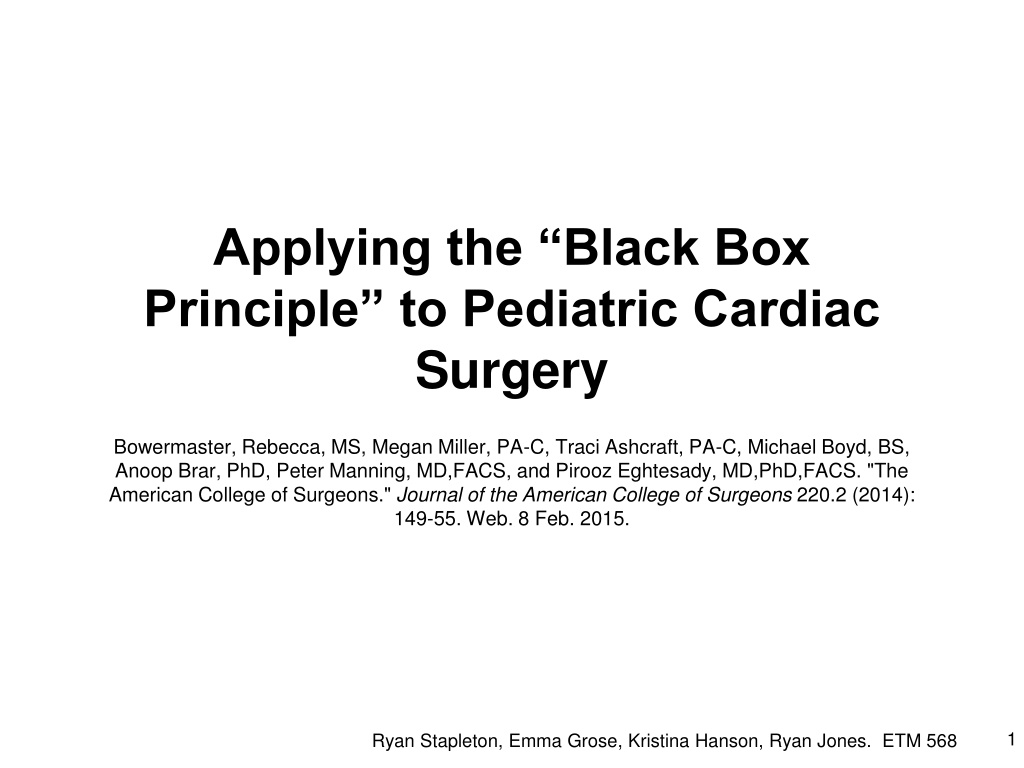Applying the Black Box Principle to Pediatric Cardiac Surgery: A Study
This study explores the application of the Black Box Principle in pediatric cardiac surgery, adapting the concept from aviation to enhance safety and performance in the operating room. By recording all failure events in real-time and analyzing data over a period of time, the study aims to improve outcomes and efficiency in surgical procedures. The results showcase insights from 951 cases performed between April 2008 and December 2010, highlighting various categories of events and the impact of this innovative approach on surgical processes.
- Black Box Principle
- Pediatric Cardiac Surgery
- Surgical Safety
- Operating Room Efficiency
- Real-time Data Recording
Download Presentation

Please find below an Image/Link to download the presentation.
The content on the website is provided AS IS for your information and personal use only. It may not be sold, licensed, or shared on other websites without obtaining consent from the author. Download presentation by click this link. If you encounter any issues during the download, it is possible that the publisher has removed the file from their server.
E N D
Presentation Transcript
Applying the Black Box Principle to Pediatric Cardiac Surgery Bowermaster, Rebecca, MS, Megan Miller, PA-C, Traci Ashcraft, PA-C, Michael Boyd, BS, Anoop Brar, PhD, Peter Manning, MD,FACS, and Pirooz Eghtesady, MD,PhD,FACS. "The American College of Surgeons." Journal of the American College of Surgeons 220.2 (2014): 149-55. Web. 8 Feb. 2015. 1 Ryan Stapleton, Emma Grose, Kristina Hanson, Ryan Jones. ETM 568
Introduction, or What is the Black Box Principle? In aviation, the black box records everything that happens in the cockpit. In the event of an accident, or near-accident, this data can be reviewed afterwards to determine the causes. This study applies the same principle to the operating room in what the authors called the Intraoperative Improvement Initiative , or I . Unlike previous studies, this study captures information on all failures, including ones other studies would have considered insignificant because they were inconsequential. Also unlike previous studies, this study did not used trained observers to report failures, instead a nurse already on the surgical team was asked to record all failures in real time on a index card. 2 Ryan Stapleton, Emma Grose, Kristina Hanson, Ryan Jones. ETM 568
Methods Before a procedure, an email would be sent to the surgeon describing the plan to record data. On the day of surgery, email would be reviewed by the team before the surgeon scrubbed in. When the operation was over, surgeon led a discussion about failure events throughout the operation Failure Events were defined as anything that was unanticipated or unplanned beginning 1 hour before the operation to until the end of the operation. 3 Ryan Stapleton, Emma Grose, Kristina Hanson, Ryan Jones. ETM 568
Methods (Cont.) As time moved forward, and operating teams grew more comfortable with the procedures of the study, the efficiency of collecting data improved. A chart with failure event rates based on quarterly surgical volumes was used to track total failure event rates. A pareto chart was used to display distribution of data among event categories. Event category analyses were performed by using chi-square tests. 4 Ryan Stapleton, Emma Grose, Kristina Hanson, Ryan Jones. ETM 568
5 Ryan Stapleton, Emma Grose, Kristina Hanson, Ryan Jones. ETM 568
Results 951 cases performed from April 2008- December 2010 o 619 open-heart o 322 closed heart 9 categories of events o access o blood o change of plan o communication o equipment o injury to patient o medication o patient instability o other 6 Ryan Stapleton, Emma Grose, Kristina Hanson, Ryan Jones. ETM 568
7 Ryan Stapleton, Emma Grose, Kristina Hanson, Ryan Jones. ETM 568
8 Ryan Stapleton, Emma Grose, Kristina Hanson, Ryan Jones. ETM 568
Results (cont.) 7.3% during closed-heart procedures o communication o patient instability o equipment and access Correlation between event types o Patient instability, access, equipment, and injury to patient o 3 times more likes to happen in tandem in a procedure Communication failures with circumstances that results in blood failures 9 Ryan Stapleton, Emma Grose, Kristina Hanson, Ryan Jones. ETM 568
Discussion Implementation of systematic approach to recording events and failures yields an increase in event rate o More data allows for a greater opportunity for more comprehensive analysis and insight on the issues o Determine links between event categories Most findings were expected, but there were many surprising results 10 Ryan Stapleton, Emma Grose, Kristina Hanson, Ryan Jones. ETM 568
Discussion (cont.) Recurrent and predictable patterns of failures reflecting the OR microenvironment o Initially unaware of these Patterns of failures were similar for both open-heart and closed-heart procedures o Equipment related more frequent with open-heart because of the use of extracorporeal circuitry o High occurrence of equipment during closed heart surgery as well, but more likely from genesis of the system together 11 Ryan Stapleton, Emma Grose, Kristina Hanson, Ryan Jones. ETM 568
Discussion (cont.) Communication with Risk Mgmt and Supply Chain Mgmt about transducer failures in isolated events o Implement quality check o Reduce dependence on a single manufacturer o Detailed tracking information on failures; contact FDA High association between events: o Patient Instability and Injury to Patient o Each 3x more likely if the other is present o Increase anticipation and impact plan 12 Ryan Stapleton, Emma Grose, Kristina Hanson, Ryan Jones. ETM 568
Questions? Thank you! 13 Ryan Stapleton, Emma Grose, Kristina Hanson, Ryan Jones. ETM 568

























